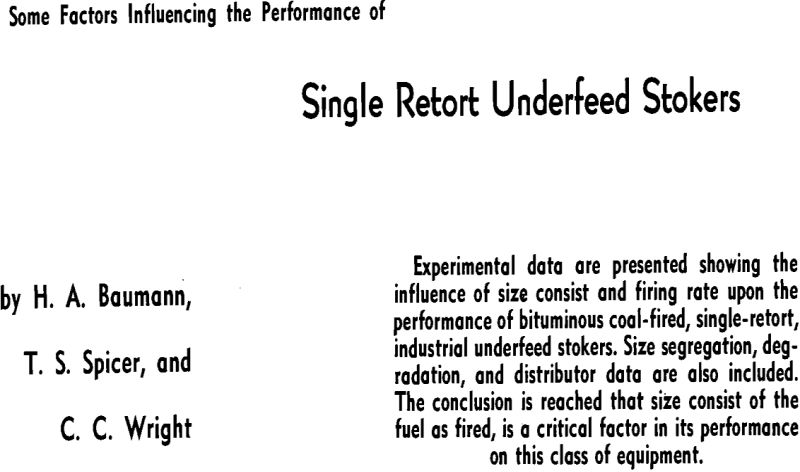Although the efficiency of coal utilization has improved steadily since the turn of the century as a result of continued research and development, little of this increase in efficiency can be credited to improvements in the single retort stoker. There are still numerous problems connected with the burning of coal on this type of unit, the solution of which would be a stimulus to coal and stoker sales and a boon to the user. Among the more critical of these problems is that of burning slack bituminous coal of strong caking tendency and containing large percentages of fine material. With the increased trend toward mechanical mining, it may be expected that in the future an even larger percentage of the coal available for use on this class of stokers will contain higher percentages of the fine sizes, thus aggravating an already serious problem.
General Considerations
There are numerous factors which appear directly or indirectly to affect the overall performance of bituminous coal underfeed stokers, such as the caking or matting properties of the coal, the contact relationships between coal and air, the ash fusion characteristics, the burning rate, and the design of the stoker and furnace in which the coal is burned. An analysis of the influence of each of these factors indicates, however, that all are interrelated and interdependent. For example, the contact relationships between coal and air has a definite bearing upon the caking and matting properties as evidenced by the phenomenon of preoxidation and its influence upon the character of the coke. Contact relationships also influence the burning rate since this reaction is a function of surface area and oxygen concentration. Similarly, the character of the coke influences the contact relationship between air and fuel, and is itself dependent upon the flow of heat to and from the fuel bed, which in turn is influenced by furnace design and by burning rate.

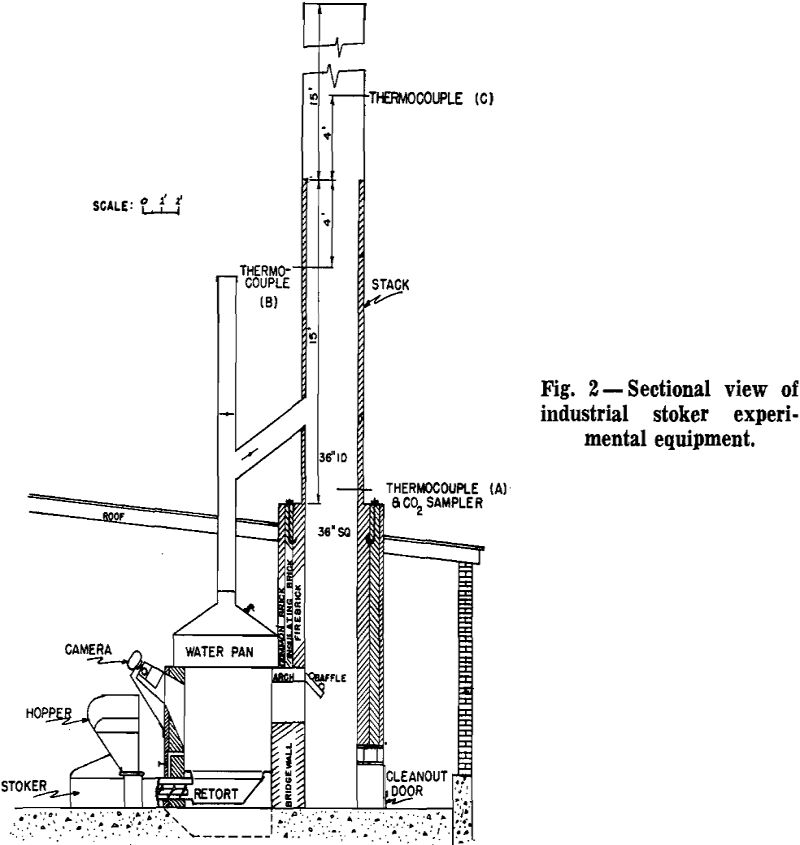
Experimental Investigations
Properties of Coals Tested: Description and Analyses: Descriptions and analyses of the coals tested are shown in table I. Although these coals were all from the Pennsylvania coal fields, it is believed that the results and conclusions are generally applicable to bituminous coal of comparable quality from other sources.
Screen Analyses: Screen analyses for each of the coals tested are presented in graphic form in fig. 4. These analyses were made as follows: a 2000 lb sample of each of the test coals was taken from stock and each was coned and quartered according to the standard ASTM procedure. Alternate quarters were combined and the 1000 lb samples were screened using the Tyler Ty-Lab shaker with 2,
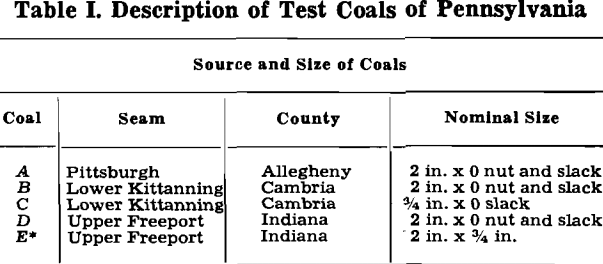
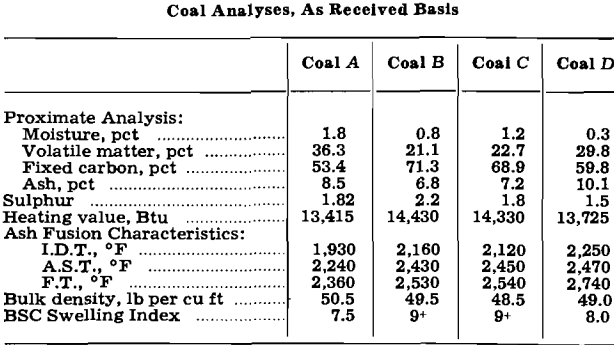
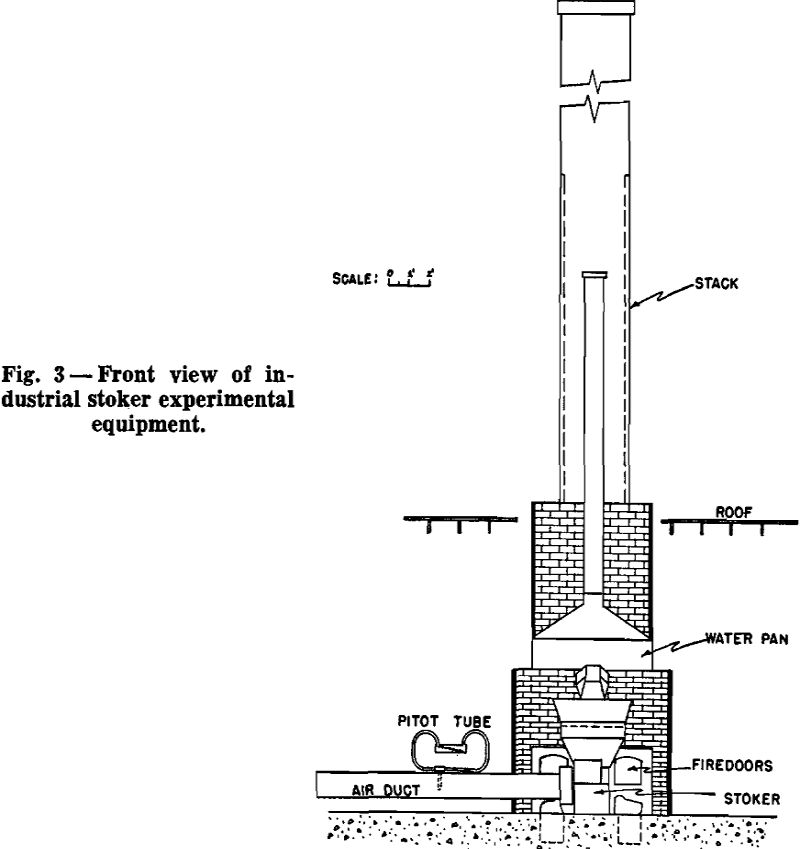
1½, 1¼, 1, ¾, and ½ in. round hole screens, and U.S. screens, No. 4, 8, and 16. The screen fractions were remixed by coning with as little handling as possible and were used in subsequent degradation tests.
Combustion Tests: A large number of combustion tests have been completed in which various factors such as shape and design of grate bar and retort, motion of distribution ram, air zoning and related mechanical features as well as such factors as the influence of firing rate, size consist of the fuel and preoxidation of the fuel by various methods have been studied. In each of these combustion tests the following standard operating procedure has been employed.
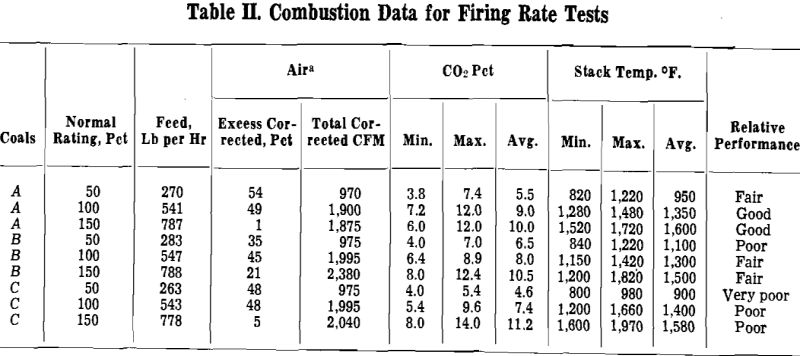
One series of tests was made at three different firing rates; namely, 50, 100, and 150 pct of rating for this particular stoker, in order to study the influence of this factor upon the performance of the various coals. The results are reported in table II. It should be noted that the percentage excess air reported in col. 4 is based on the volume of air delivered to the bed by the fan and the quantity of coal fed. Thus this is the theoretical excess rather than the actual, which is based on the CO2 content of stack gases. Since air leakage was held to a minimum, CO2 results appreciably below those corresponding to the measured excess air are an indication of the extent to which the fuel was accumulating in the bed.
Discussion of Results
Degradation: During the past decade, considerable attention has been focused upon the degradation of coal in domestic underfeed stokers, but little or no mention of this phenomenon can be found in the technical literature concerned with the operation of commercial and industrial underfeed stokers. Obviously the amount of degradation will be a function of the strength characteristics of the particular coal, of the size consist of the coal, and of the design characteristics of the particular stoker.
The general lack of information on this subject would suggest, however, that the importance of this factor in stoker performance may have been underrated.
Segregation: When transporting broken solids one of the most difficult problems encountered is that of preventing segregation of the coarse material from the fines. The problem is especially difficult with the single retort underfeed stoker because the coal must be fed from the hopper into the retort and then distributed over the grate; this involves three changes in direction.
Distribution: As the length of retort and the grate area increase, it becomes correspondingly more difficult to maintain an even quantity distribution of coal on the grates. The problem is further complicated by the fact that the distribution is affected by size consist, moisture content, and such other physical characteristics of the coal as affect its movement.
